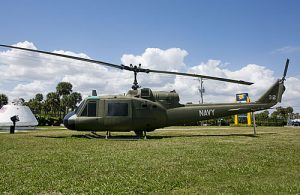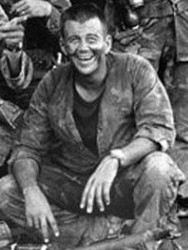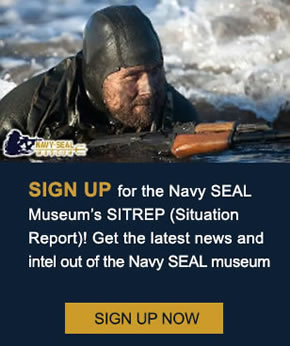SEAWOLF Helicopter
 Helicopter Attack (Light) Squadron THREE (HAL-3) was the only rapid reaction armed helicopter squadron ever commission in the U.S. Navy. It was established on 1 April 1967 in Vietnam to provide close air support for the Navy’s Game Warden River Patrol Force (a.k.a. Brown Water Navy) in South Vietnam. The need for HAL-3 was demanded by the peculiar nature of guerrilla warfare in Vietnam. This one of a kind naval aviation unit played a major role in the American led campaign to deny Viet Cong use of all important waterways in the Vietnam Delta regions.
Helicopter Attack (Light) Squadron THREE (HAL-3) was the only rapid reaction armed helicopter squadron ever commission in the U.S. Navy. It was established on 1 April 1967 in Vietnam to provide close air support for the Navy’s Game Warden River Patrol Force (a.k.a. Brown Water Navy) in South Vietnam. The need for HAL-3 was demanded by the peculiar nature of guerrilla warfare in Vietnam. This one of a kind naval aviation unit played a major role in the American led campaign to deny Viet Cong use of all important waterways in the Vietnam Delta regions.
HAL-3 pilots began flying heavily armed Bell Aviation UH-1B and UH-1M Huey helicopters. Nicked name “SEAWOLVES,” they commenced providing rapid reaction close-air support to host of navy craft, and often provided dedicated armed reconnaissance and fire support to Navy SEALs. Indeed, SEALs and SEAWOLVES became an inseparable and dominating warrior team in areas where they were co-located.
In 1969, HH-1K and UH-1L Huey “Slicks,” also built by Bell Aviation and nicked named “SEALORDS,” were added to the HAL-3 inventory. These were navy helicopters used primarily for logistic resupply; however, working in combination with SEAWOLFS, they were also involved in combat missions, which routinely involved inserting and extracting SEALs.
Best of the Best
“We Seawolves had a ‘Great’ mission. If it weren’t for the Seawolves and their sacrifices, many more names would be on this wall. Indeed, we Seawolves were the “Best of the Best.” We dared to go when and where others would not go. People need not take our word for this. All they have to do is ask the units our squadron supported. Ask the “Brown Water Navy” Sailors, including the SEALs and UDT. Ask the U.S. Army and Marine Corps Special Forces and advisors. Ask the Green Beret, LRP, Mobile Strike Force and Ranger Team members. Ask the South Vietnamese villagers who were in danger of being over run by the VC and NVA.”
Vietnam Memorial Speech
Washington DC, July 4, 1996
By Tom Olby, HAL-3 Seawolves, Det 1 (1968-1971)
“Scramble Seawolves!”
 “Among the armed forces of the United States, U.S. Navy SEALs are frequently the “tip of the spear” – the first to penetrate and the first to draw blood. However, the tip is also the most vulnerable part of the blade, the first part to be to be blunted. It must be inserted in the right place at the right time or be shattered. It is also the smallest part of the blade, and improperly applied, it can easily be broken against enemy armor.
“Among the armed forces of the United States, U.S. Navy SEALs are frequently the “tip of the spear” – the first to penetrate and the first to draw blood. However, the tip is also the most vulnerable part of the blade, the first part to be to be blunted. It must be inserted in the right place at the right time or be shattered. It is also the smallest part of the blade, and improperly applied, it can easily be broken against enemy armor.
Navy SEALs operated in Vietnam in commando units as small as four men and rarely more than fourteen. They penetrated deep into Viet Cong and NVA strongholds to capture or eliminate the Communist infrastructure. The SEALs were soon to become masters of camouflage, and were able to move through the jungle without detection and under the cover of darkness. Upon reaching their objective, they were often met with overwhelming odds. Then the tip of the spear needed help from above, and radio silence had to be broken. The word went out: “Scramble Seawolves!”
In Vietnam for maximum mobility and firepower over the jungles and rice paddies, the helicopter was the essential support vehicle for our riverine forces. The navy’s answer to the problem of SEAL support in an operating environment of unbroken jungle, rice paddies, or open water was the UH-1B helicopter gunship, call sign Seawolves. Mounted on each side of the Seawolf Hueys were 2.75-inch rocket launchers, and two M-60 flex-mounted machine guns per side. Unique to the Seawolf gunships were its two gunners, one seated on each side of the helicopter with a freehand, shoulder-fired M-60 machine gun. These very special young gunners hung out of the helicopter with one foot on the rocket pod and fired to the side, under, and to the rear, as the gunship rolled in and out of an attack run.
Not only does many a SEAL owe his life to the Seawolves, but the units often operated together as a team. Very often located at the same base of operations, we developed friendships that are still alive today. Operating well outside standard operating procedures, the Seawolves have lifted SEALs out of enemy encirclements, and I have known them to land in a hot LZ [Landing Zone] to lift out caches too large for the SEALs to pack out. The also evacuated our wounded, when medevac helicopters were not available. Most important they were always there for us, when we were down in the mud and darkness; the night illuminated with red and green tracers; the VC behind every shadow. Many times, after we were out of danger, they stayed with us until we were safely extracted, in the middle of the river, and out of range of enemy fire.”
Barry W. Enoch
GMGC, U.S. Navy (Ret.)
SEAL Team ONE

